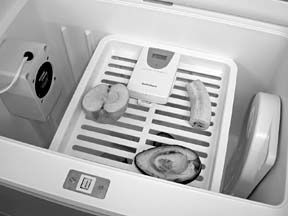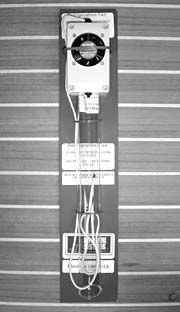Practical Sailor has done a fair amount of reporting in the past couple of years on the topic of keeping food cold on board. In the October 1, 2002 issue we published the results of a reader survey, which indicated that both evaporator and cold plate system have reached a high state of development, and are generally trustworthy. But while maintenance and customer service will remain important issues, along with power use and insulation, there’s another concern that we rarely hear about, and it’s the inconsistency of temperature throughout the typical sailboat icebox. Depending on the location of the evaporator or cold plate, and on the general layout of the box, about the only thing we can be sure about is that the coldest air will be at the bottom.

Gary Southby of Offshore Systems in San Diego, CA, sent us samples of a device of his making, called the Tubefan (priced at $135 on his website). The name encompasses the whole thing: It’s a fan in a plastic box, with a clear plastic tube sticking out the bottom, connection wires, and an on/off switch. The box mounts near the top of the icebox with adhesive pads (make sure the box is at room temperature, and the surface wiped clean with alcohol) and the end of the tube is set close to the bottom of the space, in order to pull cold air from the bottom and fan it out at the top. The tube can (and usually will) be cut to fit the depth of the box, then simply reinserted into the fan box.
The current draw is about 0.2 amps at 12 volts. The directions say that power “can normally be supplied from the refrigeration machinery main power connection at the compressor assembly,” but the power cord can be extended if necessary. Obviously, great care must be taken in a permanent installation if wires must be run through the icebox insulation.
The point of the fan is not to increase the chill in the icebox, but to equalize and stabilize the temperature throughout, eliminating “hot spots” and taking some of the guesswork out of how to stow the butter versus the beer. Gary Southby tells us that customers have reported that their food tends to last longer on cruises, by two to three days, and is more evenly chilled with the Tubefan in operation. Without it, he says, people have to run their refrigerators at colder temperatures in order to keep the food at the top cold, so the Tubefan can allow a higher temperature setting, thus saving some power (even though it uses some itself) in the long run.

We experimented with the Tubefan over the course of several days, using a 40-quart Coleman Power Chill thermoelectric cooler (tested and reported on in the June 2003 issue), a 12-volt power supply, Radio Shack remote-sensing indoor-outdoor thermometers, and a Raytech MiniTemp Laser Heat Sensor. (This is a very handy device, by the way—you simply point it at an object, pull the trigger, and the surface temperature you’re shooting at is reported to you with remarkable accuracy.)
In the first test we cut an apple, a banana, and an avocado in half, put halves of each high on a shelf and low on the bottom of the cooler, and ran the cooler for 24 hours without the Tubeban. We were curious to see if the warmer produce, up top, would deteriorate any faster than the colder produce down low. Then we repeated the whole thing with new fruit and the Tubefan running. (This was at a constant office temperature.)
We did find that the fruit was a bit more evenly oxidized with the Tubefan on, although no less so overall, to our eye, than with the fan off. More to the point, the fan definitely evened out the temperatures in the chest: Without it there were big differences from top to bottom. In one case it was a whopping 11° (33° vs. 44°). With the fan, air temperatures, measured by thermometers, and box-side temperatures, measured with the laser sensor, were always within about a degree everywhere in the box (38°, for example) except at the very top near the lid. More interesting and obvious was the effect the Tubefan had on the cooler’s operation. Without it, the cooler lost much of its efficiency within 24 hours because the thermopile tended to ice up. On two occasions we found temperatures up around 56°. With the Tubefan, there was never any ice formation. We suspect that it would have the same beneficial effect on a standard evaporator system or cold plate.
A secondary use, though probably just as valuable, would be to circulate air in stowage lockers to prevent formation of mold and mildew.
Contact – Offshore Systems, Inc. 619/221-0101, www.offshoresystems.us.
































